|
|
|
|
|
|
 Official name:
Republika Hrvatska (abbr. HR, Republic of Croatia).
Note that the "H" in Hrvatska is pronounced as
the Scottish "ch" in "loch" (phon. symbol: χ). There are some theories
regarding the origin of the name: The tribe of the Alans, once
settling in the (nowadays Russian) Don area, used the following word for
"friend": Huarvatha. (see also
→about the name 'Croatia')
Area: 56,538 km². Substantially smaller than Ireland
and about as big as West Virgina. Not less than 1,185 islands belong to Croatia -
but only around 70 are inhabited.
Population: almost exactly 4.5 million* (2004) (half the population of Greater London);
but Croatia faces a serious population problem:
The birth rate is extremely low and therefore the netto growth rate is negative.
Ethnic groups:
Croats 89.6 %, Serbs 4.5 %, and some minorities (all of them less than 0.5%) eg
Bosniaks, Hungarians, Slovenes, Czech, Roma etc (2001)*.
Due to the war, many Serbs fled the country, leading to the homogenization of
Croatia's population, which is quite a novelty in Croatian history.
Religion:
Most of the Croats are Catholic, and so there's a parity between ethnic group distribution
and religion: 87.8% are Roman-Catholic, 4.4% (Serbian-)Orthodox, 1.3% Moslems, 1.3% others
(as of 2001)*.
Time zone: As in middle Europe: GMT +01 hr, with daylight-saving time
(+1 hour) in summer.
Language: Official language is Croatian. It's not a long time ago that the language was refered to as
Serbo-Croatian, although there are substantial differences between Serbian and Croatian (see below).
Official name:
Republika Hrvatska (abbr. HR, Republic of Croatia).
Note that the "H" in Hrvatska is pronounced as
the Scottish "ch" in "loch" (phon. symbol: χ). There are some theories
regarding the origin of the name: The tribe of the Alans, once
settling in the (nowadays Russian) Don area, used the following word for
"friend": Huarvatha. (see also
→about the name 'Croatia')
Area: 56,538 km². Substantially smaller than Ireland
and about as big as West Virgina. Not less than 1,185 islands belong to Croatia -
but only around 70 are inhabited.
Population: almost exactly 4.5 million* (2004) (half the population of Greater London);
but Croatia faces a serious population problem:
The birth rate is extremely low and therefore the netto growth rate is negative.
Ethnic groups:
Croats 89.6 %, Serbs 4.5 %, and some minorities (all of them less than 0.5%) eg
Bosniaks, Hungarians, Slovenes, Czech, Roma etc (2001)*.
Due to the war, many Serbs fled the country, leading to the homogenization of
Croatia's population, which is quite a novelty in Croatian history.
Religion:
Most of the Croats are Catholic, and so there's a parity between ethnic group distribution
and religion: 87.8% are Roman-Catholic, 4.4% (Serbian-)Orthodox, 1.3% Moslems, 1.3% others
(as of 2001)*.
Time zone: As in middle Europe: GMT +01 hr, with daylight-saving time
(+1 hour) in summer.
Language: Official language is Croatian. It's not a long time ago that the language was refered to as
Serbo-Croatian, although there are substantial differences between Serbian and Croatian (see below).
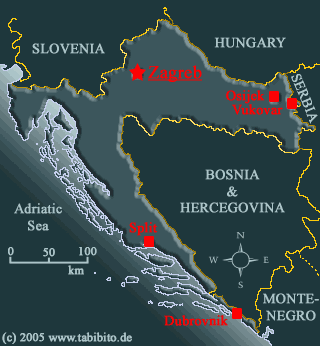 As in →Slovenia and the Federation of Bosnia and Hercegovina (FD, see
→Bosnia), Latin script is used in Croatia. However, there
is a handful of diacritical symbols, which should not be ignored.
As in →Slovenia and the Federation of Bosnia and Hercegovina (FD, see
→Bosnia), Latin script is used in Croatia. However, there
is a handful of diacritical symbols, which should not be ignored.
Below the reading of diacritical marks and letters with a different pronunciation to English
(note that all vowels are read as in Roman languages, ie 'a' is read as
the 'a' 'star', 'e' as 'ei' etc):
- C (c) is always read as the 'ts' in 'Tsar'
- Ć (ć) is read as the 'tch' in 'kitchen'.
- Č (č) is read as the 'ch' in 'chain' (slightly softer than ć).
- Đ (đ) is rarely used in Croation and read as the 'du' in 'education' (but softer).
- H (h) is always read as the 'ch' in the Scottish word 'loch'.
- Š (š) is read as the 'sh'-sound in 'cash'.
- Ž (ž) is read as a voiced 'sh', ie as the 'g' in 'genre'.
There are many common things between Serbian and Croatian, since both of them belong to the
southern branch of Slavic languages. However, there are also many differences. As for example
in the pronunciation of certain letters and combinations: A long [e]
in Serbian is written and pronounced [ije] (resp -iye) in Croatian. Eg the Serbian word
[река (reka)], which means 'river', becomes
[Rijeka]. A short, Serbian [e] often becomes [je] (resp. -ye) in Croatian. But it's not only the
pronunciation that makes the difference. There are even substantial differences in grammar
and, of course, a distinctive vocabulary. As for instance the Serbian salutation 'Zdravo', which was
used throughout Yugoslavia during Tito's reign. Today, 'zdravo' is not any longer in use in Croatia.
For a table with the most important vocabulary in Bulgarian
and other Slavic languages →click here.
Many young people and of course staff at facilities along the coastline often speak English.
Anyway, German is more useful in Croatia.
|
|
|
|
|
|
|
Croatia offers an amazing diversity of landscapes. As for example the plain of the
Podravina, which is a part of the vast Pannonian plain, along the border to →Hungary
in the north of Croatia, and the wide Sava valley. Next is the mountainous but not steep area of
Slavonija (Slavonia) with almost 1,000 m high mountains and hills. The central part of Croatia is called
Kordun and dominated by rolling hills. Another part is the large
Istra (Istria) peninsula in the west, consisting of mountains along the east coast and a small plain along the west coast.
The most dramatic landscape can be found in Dalmatia. There, the around 1,500 m high mountain ridge of the
Dinaric Alps straddles the border to →Bosnia-Hercegovina.
The entire area between Istria and the Dinaric Alps is characterized by limestone and therefore it offers a marvellous
karst topography with numerous polye, dolina (large and small collapsed valleys), ponors (sinkholes, where rivers etc simply vanish), caves etc.
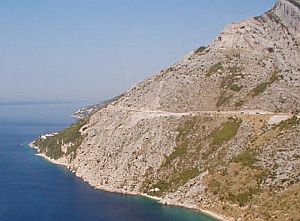
| |
Dalmatia: That's a steep coast and crystal clear water
|
The highest summit of Croatia is the 1,830 metres high Dinara - of course in the Dinaric Alps near the city of Knin.
The topography as wells as the sea current define the climate of Croatia. The Dinaric Alps running parallel to the coastline
protect the latter from cold winds coming from the north. Therefore, the winter at the seaside is rather short and mild. In contradiction to that,
the north of the country can become very cold. The summer at the sea is hot and dry, but thanks to a constant onshore wind it appears to be
a pleasant climate. Since the water of the Adriatic Sea flows northwards along the Dalmatian coast, the water temperature is quite
high in summer and not really low in winter.
|
|
|
|
|
|
|
Present-day Croatia as well as the surrounding area was first inhabited by Illyrian tribes, to be followed by
ancient Romans. The colonization probably started at the Dalmatian coast near →Split;
a city, which eversince plays an important role in the history of Croatia. After the Roman Empire had been
divided into East and West in 395 AD, Croatia, together with present-day →Bosnia and
→Slovenia, became part of the Western Roman Empire. On the other hand,
→Serbia, →Macedonia and so on
had been taken over by the Byzantine Empire. Since the 6th century, first Slavic tribes settled in the area. The strongest tribe among them
was the Slavic tribe of the Croats. Later on, the northern part belonged to the Frankish kingdom, whereas the south was conquered by the
Byzantine empire. In 925, the northern and the southern part merged together to form the Kingdom of Croatia.
The newly formed kingdom prospered for around 200 years. After that, the northern part decided to unite with
→Hungary. The southern part, ie Dalmatia, was taken over by strong
Venetia. This shouldn't change during the next centuries. However, in the years 1241/2, a vast horde of
Mongols (see also →History of Hungary) devastated the entire area.
The Ottoman empire, successor to the Byzantine Empire, gradually invaded almost all of the Balkans, but it never conquered Dalmatia.
In contradiction to that, the north of Croatia became part of the Habsburg monarchy after the defeat of the Ottomans over Hungary in 1526.
Logically, northern Croatia later on became a province of Austria-Hungary. At that time, many so-called
Krajina-Serbs (Krajina means border) were settled in the area along the border with the Ottoman Empire in order to
secure the border. The Serbs of the Krajina were about to play an important but tragic role in the 1990ies. The history of
→Dubrovnik was an exception to the rest of Croatia - for a very long time, Dubrovnik was
able to remain independent as the so-called Republic of Ragusa.
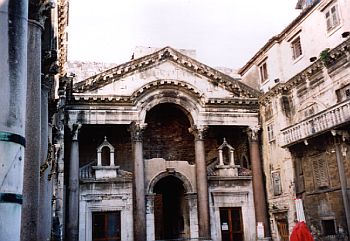
| |
1,700 yrs old Diocletian's Palace in Split
|
It is one of the miracles of the 20th century, that, despite all the hatred and killings, Yugoslavia re-formed soon after the end of WWII - this time under
the wings of the Soviet Union and the reign of the Croatian-Slovenian governor Marshal Tito and a central government in
→Belgrade. After the death of Marshal Tito in 1980, Yugoslavia started to crumble. The political situation became gradually
unstable; additionally, a big regional gap in the affluence of Yugoslavs marked another source of annoyance (as it does in other countries, eg Italy).
To be more exactly, the standard of living in →Slovenia and Croatia was much higher than in the
rest of Yugoslavia. After the beginning of Glasnost', the Perestroika and the fall of the Berlin Wall, first democratic elections were held in Croatia in 1990.
This election was won by a non-communist, namely Franjo Tudjman, a former partisan general and leader of the
Croatian Democratic Union.
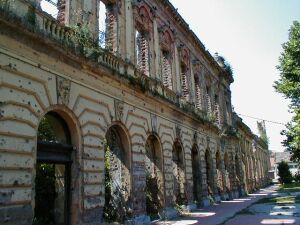
| |
Completely destroyed: Vukovar in East Slavonia
|
Within three months, the Yugoslav National Army seized around ¼ of the entire country. As a countermeasure,
Croatia blocked all JNA barracks on its territory. In order to lift the blockade, the JNA, now an alliance between Serbia and Montenegro,
started to attack Southern Dalmatia around →Dubrovnik. The latter was besieged and came under heavy
mortar shelling. Meanwhile, Serbian jet fighters attacked →Zagreb, trying to kill the Croatian president.
They didn't succeed, but some civilians were killed. In 1995, negotiations about a truce were brought to a grinding halt.
Croatia concentrated its forces in the military operation Blijesak (lightning) and recaptured West Slavonia.
Less than three months later, Croatia started another campaign called Oluja (storm) to
recapture the Krajina. Only East Slavonia around →Vukovar remained under Serbian control.
As a result of the military operations, more than 100,000 Serbs had to flee their homes in an instant.
The Dayton Accord of 1998 settled the unsolved conflict over East Slavonia. Serbia had to hand over East Slavonia,
but the Serbs - even today more than 50% of the population there - are allowed to stay in East Slavonia, protected by international observers.
Croatia with its present borders is internationally recognized.
The country is recovering more or less quickly. This is also thanks to the tourists coming back to Croatia. Today, there's a strong cooperation
between the European Union and Croatia. The economy is booming, although unemployment in some areas exceeds 20%. However,
the most important thing at the moment is the stabilization of the political situation of Croatia and the neighbouring countries.
|
|
|
|
|
|
|
Prologue: Croatia was a very popular place with
tourists before the war, even during the Yugoslav period, and it became a popular place
again after the end of the war. Most tourists are tempted by the beautiful (although rarely sandy) beaches,
the warm water and the impressive landscape. Additionally, ancient cities such as →Split
and →Dubrovnik, conveniently located at the seashore, make it a
worthwhile destination. Needless to say that we were highly interested in Split and Dubrovnik as well,
but we were also interested in what Croatia looks like in less frequented areas. Although we couldn't spend a
long time in the country, we've soon found out that Croatia is not Dalmatia - there's a great gap between
the coast and the other parts of the country.
Visa:
Most Europeans and many other nationalities do not require a visa - a passport is enough.
As with most other countries, the passport should be valid for at least three more months upon arrival.
Money:
The Croatian currency is called Hrvatska Kuna (HRK), shortly called "Kuna".
One Kuna consists of 100 Lipa. The inflation rate is very low. Not to say zero or less -
in 2001, one euro was worth 9 Kuna, in 2004 it was € 1 = 7.5 Kuna.
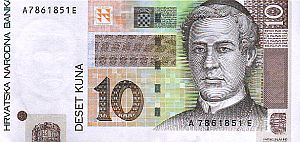
| |
Croatian 10-Kuna bill
|
The Croatian currency is freely convertible, which means that changing money is no problem at all.
It's even possible to exchange Croatian Kuna at some exchange booths in neighbouring countries,
although the exchange rate is much worse outside the country.
There is no lack of ATM's in bigger cities, accepting common credit cards and
Maestro, Cirrus (formerly EC) etc cash cards. The usual fee per transaction is € 4. Cash can be exchanged everywhere,
especially along the coast. Many hotels also accept Euro and USD.
Costs:
Croatia, especially the touristy area along the coastline, is going to get more and more expensive.
Still, it's slightly cheaper than →Slovenia but
substantially more expensive than →Serbia,
→Macedonia and
→Bosnia & Hercegovina.
Very active travelers staying overnight in private accommodation should
expect to pay at least € 30 per day. You can save a lot of money by buying your food on
your own - however, by doing this, you will miss many culinary delights.
Accommodation:
Finding a place to stay along the coast should be the least of your worries. At least not during the season.
It doesn't matter whether you arrive by bus, train or boat - many, mostly older women, approach
immediately and offer private rooms (Sobe). Sometimes it's possible to
negotiate for the price, sometimes it isn't. The rooms are often basic but clean. The family
can be open-minded and very nice, but they can also be completely uninterested. Of course there's
a gap in prices and offers between the season and off-season. The price for a private room
during summer is mostly between € 10 and € 15 for one night and one person.
In contradiction to that, it's rather hard to find reasonable accommodation in Slavonia and other,
less frequented parts of the country. No tourists - no big variety. In some bigger cities off the
beaten track, you will only find one or two rather expensive hotels (however, prices are mostly appropriate).
Getting there:
It's possible to get to Croatia on the bus, the train or the plane. There are numerous direct connections.
Especially during the summer months, countless charter and some regular flights connect
→Zagreb and every bigger city at the sea with virtually every big city in
Europe.
Additionally, many ferries cross the Adriatic Sea. Major ports in Italy for
ferries running to Croatia include Bari, Ancona and Venice.
There are many direct buses throughout the entire year from Austria, Germany and many other countries.
Sometimes it's the only way to get to and from Croatia: There are no other means of transport
(except airplanes of course) between Croatia and →Bosnia & Hercegovina.
The same can be said about Montenegro (see also →Dubrovnik and →Kotor).
Croatia's connection to the international railway network is excellent. The main hub of course is the
central train station of →Zagreb. From there, direct trains run to
Munich (9 hrs, from Zagreb during the daytime, to Zagreb as a night train),
Vienna (6½ hrs), several trains per day to →Ljubljana
(less than 2½ hrs, above-mentioned trains are all via Ljubljana as well), to
Thessaloniki in Greece (22 hrs, stopping after 16 hrs in →Skopje),
to →Belgrade (6 hrs, the train to Thessaloniki is via Belgrade, and also via
→Novi Sad), to →Budapest (to Deli pu., around 5 hrs)
and even as far as Bratislava (in →Slovakia, 6½ hrs).
Note that there are no trains from Zagreb to Bosnia & Hercegovina, except for one train running between
Ploče at the sea and →Sarajevo via
→Mostar. It's limited to only one or two trains a day and I'm not sure whether
this connection is still served. Recently, it's possible to board the express train running between →Budapest
and →Sarajevo in →Osijek in East Slavonia. During the
war and some years after the war, this useful connection was out of service (I can sing a song about that...)
Traveling to Croatia from Germany? Ask at the ticket counter of your local train station for the
Kroatien-Spezialticket. It's a return ticket from a city of your choice in Germany to
a city of your choice in Croatia. Advantage: fellow travelers only pay half the price (in 2001, a return ticket for
two persons was around € 280). Drawback: The route is fixed (but not the time). But you can get off and jump on the
train whereever you want. The route between Germany and Croatia is very scenic (because of the Alps).
Border crossings: :
There are countless border crossings to the neighbouring countries. Entry procedures
are usually fast and without any problems. However, crossing the border to
→Bosnia may involve time-consuming luggage checks,
which might take up to two hours. There's a small stretch of Bosnian territory at the Adriatic Sea around the
Bosnian city of Neum halfway between Split and Dubrovnik. This stretch is only 20 km
long, and most vehicles (esp busses) can pass through hassle-free. Further to the south there's one street border
crossing to Montenegro.
Getting around :
Croatia has a wellveloped infrastructure and an effective mass transportation system.
However, trains to the coast only run as far as →Split resp Ploče.
Which means that you can only get from there to →Dubrovnik by bus, ferry or
car. The long-distance bus system is excellent. Most long-distance busses are very modern. Be aware, that
there's an extra fee for bulky luggage (incl large backpacks!).
Most Croatian islands are served by ferries called Jadrolinija. Some ferries just connect
the islands with the coast, others run all the way along the Dalmatian coast. Ferries are slightly more expensive than
busses. Needless to say that there are different price categories on long-distance ferries. The cheapest
seats are on deck. Some of the ferries served the islands of →Japan before,
so don't be surprised when everything is written in Japanese!
Food and drinks:
Čevapćići and Burek and Co!
The typical Balkan stuff. Burek is some kind of greasy meat or cheese pie, often eaten for breakfast.
For more information on the Balkan cuisine, see also →Macedonia and
→Serbia.
Seafood alone makes a very good reason for traveling the Dalmatian coast.
Small squids filled with cheese and grilled with garlic for example are extremely delicious.
Everywhere along the seashore, many seafood restaurants offer mostly great dishes for reasonable prices.
Italy is not far - and this can be said about the local cuisine, too. You will find an Italian restaurant virtually everywhere.
Most of them are pretty good and not too expensive. By the way, the Dalmatian coast has been taken over by the Italian espresso
industry, ie Lavazza and Segafredo. This means that you will get a genuine espresso everywhere.
Hope they will take over Japan too...
Croatia produces very good wine. And the typical Balkan firewater. Among them, Rakija and
Šljivovica - made of grapes and plums, are highly common. One Croatian liquor is
worldwide available in bars: Maraschino - a clear and very sweet liquor made of sour cherries.
Needless to say, that beer (pivo) is popular as well. Not to mention the usual soft drinks and some excellent mineral water,
often carbonated.
|
|
|
|
|
|
|
www.vlada.hr:
Official website of the Croatian government. The English version is extensive, too.
www.dzs.hr
Call me a freak, but I think this website is interesting, too:
English version of the Croatian Bureau of Statistics.
www.tkuzmic.com/dictionary
Very useful English ↔ Croatian online dictionary.
www.krajinaforce.cjb.net
Slightly frightening website of the (actually dissolved) Serb Republic Krajina.
However, among others the forum contains interesting articles about massacres
of Serbs - something which was widely ignored by the western 'free' press. Sure
there's a lot of propaganda, though.
Do you have or do you know a good website about Croatia? Don't hesitate, let me know!
After checking it, I would love to add it to the link list.
Please note that commercial websites will be declined. For e-mail link see menu on the left.
|
|
| |